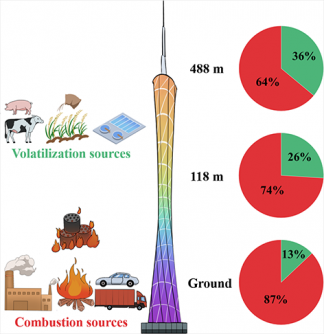Top Stories
Combustion Activities Drive Atmospheric Ammonia Surge in China

URGENT UPDATE: Researchers from Jinan University have just unveiled a groundbreaking study revealing that combustion-related activities are the primary source of atmospheric ammonia in the Pearl River Delta (PRD), China. Published in the journal Frontiers of Environmental Science & Engineering, this research has significant implications for air quality and public health.
The study highlights the alarming role of ammonia (NH3) as a key precursor of fine particulate matter (PM 2.5), which poses serious health risks. Researchers collected PM 2.5 samples from three heights—ground level, 118 m, and 488 m—using the atmospheric observatories located at Canton Tower, the tallest structure in the PRD. The results are concerning: average NH4+ concentrations were found to be 2.7 ± 1.4, 3.0 ± 1.8, and 2.6 ± 1.7 μg/m3 across the three heights, with no significant difference detected among them.
However, the stable nitrogen isotope composition values in NH4+ showed a significant correlation with height, indicating that local emissions vary dramatically with altitude. The source apportionment analysis revealed that combustion sources—including agriculture, waste, vehicle emissions, biomass burning, and coal combustion—account for a staggering 29% ± 8.0% of NH3 emissions at ground level.
The findings are critical as they emphasize the urgent need for better regulatory measures to control emissions from combustion activities. At 488 m, the contributions from these sources remained stable, highlighting the limited impact of local activities on higher atmospheric levels.
This study sheds light on the pressing need for action against pollution in urban areas, as the health effects of PM 2.5 are well-documented, increasing risks of respiratory diseases and other health issues. As cities like those in the PRD continue to grow, understanding the sources of air pollution becomes paramount for public health and environmental safety.
What’s next? Researchers and policymakers must prioritize strategies to mitigate combustion emissions and improve air quality management. The public is urged to stay informed about local air quality issues and support initiatives aimed at reducing pollution.
For further details, the full study is available at: Frontiers of Environmental Science & Engineering. Share this urgent news to raise awareness about the critical issue of air pollution in the Pearl River Delta.
-

 Health5 days ago
Health5 days agoRare Brain Condition Discovered More Common in New Mexico
-

 Politics6 days ago
Politics6 days agoPrince Andrew Steps Back from Royal Duties Following Epstein Memoir
-

 Entertainment6 days ago
Entertainment6 days agoTrump Commutes George Santos’ Sentence, Sparks Controversy
-

 Sports6 days ago
Sports6 days agoMLS Decision Day 2025: Playoff Spots on the Line as Teams Clash
-

 World6 days ago
World6 days agoYoung Driver Dies in Collision with Box Truck in El Cajon
-

 Health6 days ago
Health6 days agoRemembering Mary Ingleby: A Life of Love, Teaching, and Music
-

 Science6 days ago
Science6 days agoIdaho State University Launches Haunted Science Laboratory on Oct. 25
-

 Politics6 days ago
Politics6 days agoNavy Veteran Max Quattromani Launches Campaign for Assessor Seat
-

 Lifestyle6 days ago
Lifestyle6 days agoKent Hamilton Named Southeastern Farmer of the Year at Expo
-

 Sports6 days ago
Sports6 days agoSaquon Barkley Reacts to James Franklin’s Dismissal from Penn State
-

 Health4 days ago
Health4 days agoScientists Warn: Human Brain Struggles to Function After Midnight
-

 World6 days ago
World6 days agoHamas to Return Additional Hostage Remains on Friday








